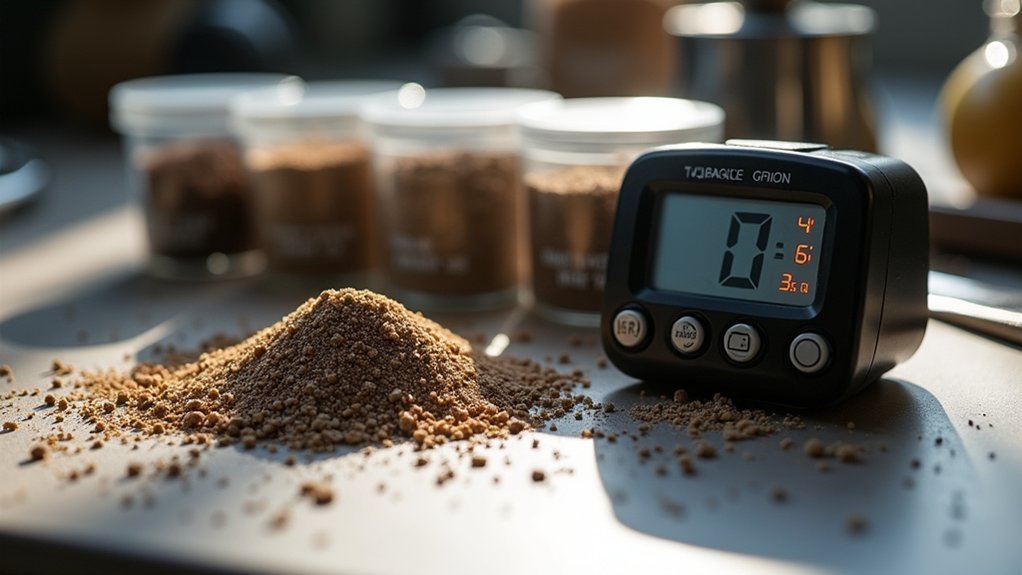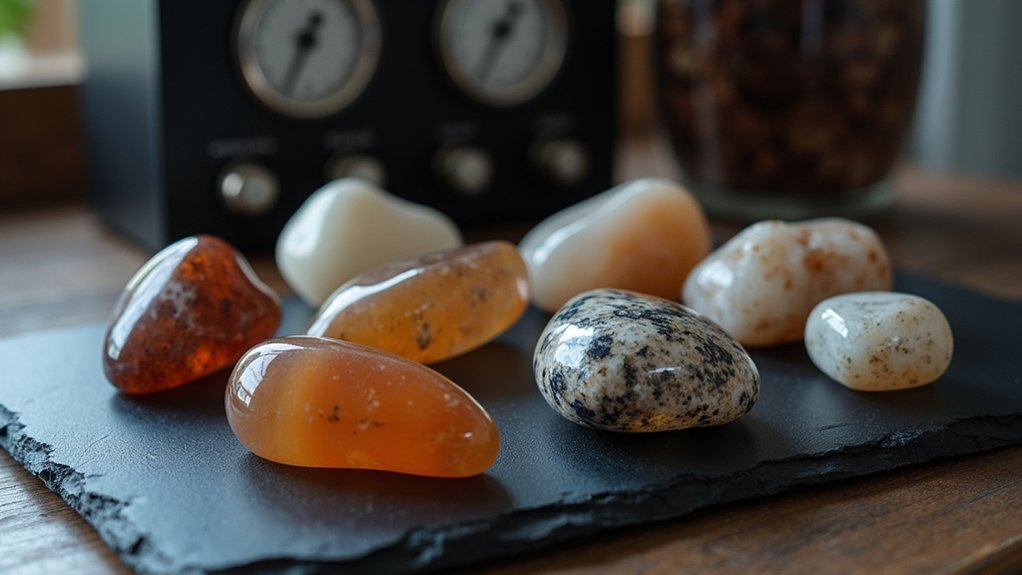You’ll need to run each tumbling stage for approximately seven days, starting with coarse grit for 7-10 days to shape your rocks and remove major chips. Follow with medium grit for another seven days to smooth surfaces, then fine grit for seven days to prepare for polishing. Complete the process with 7-10 days of polishing compound for that mirror-like finish. Harder materials may require extending each stage by several additional days, and you’ll discover the specific timing adjustments that’ll perfect your results.
Understanding Tumbler Timer Fundamentals

When you’re setting up your rock tumbler, understanding the timer fundamentals will determine whether your stones come out beautifully polished or disappointingly rough.
Your tumbler should run continuously for each stage, typically lasting 6 to 10 days depending on rock hardness and grit type. You’ll want to tumble rocks for about 7 days during each grinding phase – coarse, medium, and fine grind stages all follow this timeframe.
Each tumbling stage requires 6-10 days of continuous operation, with most rocks needing approximately 7 days per grinding phase.
Don’t rush the process by shortening these durations. Your rocks need adequate time to achieve proper shaping and smoothing at each level.
Remember to check the amount of water regularly, as proper liquid levels guarantee consistent tumbling action. After each stage, inspect your rocks carefully. If imperfections remain, they’ll need additional time before advancing to the next grit level.
Stage One Coarse Grit Timing Requirements
Stage one’s coarse grit phase sets the foundation for your entire tumbling project, requiring precise timing to achieve ideal results.
You’ll need to run your tumbler for approximately seven days during this initial stage. Fill your barrel between 1/2 to 2/3 full with rocks, then add two level tablespoons of grit per pound of rock material.
The stage one coarse grit period shapes and smooths your rocks effectively when you maintain this seven-day schedule.
After completing the cycle, thoroughly rinse all rocks to remove grit and rock mud completely. If your rocks haven’t reached desired smoothness levels, extend the process for another week before advancing to medium grit stages.
Stage Two Medium Grit Duration Guidelines

After completing your initial coarse grit phase, you’ll shift into stage two’s medium grit duration, which requires another seven-day tumbling period for ideal smoothing.
Before starting, thoroughly clean all coarse grit and rock mud from your rocks and tumbler barrel to prevent contamination that could affect results.
Add two level tablespoons of medium grit (110/220 or 150/220) per pound of rock you’re tumbling.
Fill your barrel with water until it reaches just below the top of your rocks, ensuring proper grinding action throughout the process.
Run your tumbler for seven days continuously.
After this period, inspect your rocks carefully to assess their progress.
If they haven’t achieved the desired smoothness, continue tumbling for additional time before advancing to stage three.
Stage Three Fine Grit Time Recommendations
Once you’ve finished the medium grit phase, you’ll shift to stage three’s fine grit process, which typically requires seven days of continuous tumbling to achieve proper smoothing and pre-polishing.
You’ll need to start with a completely clean tumbler barrel to prevent contamination from previous stages. Add two level tablespoons of fine grit per pound of rock when loading your tumbler for this stage.
During rock tumbling stage three, you should inspect your rocks regularly to assess their progress. This’ll help you determine if they need additional time for further smoothing.
After the seven-day period ends, thoroughly rinse all rocks to remove any remaining fine grit particles before advancing to the final polishing stage.
Stage Four Polish Time Settings

You’ll need to run your tumbler for 7-10 days during Stage Four to achieve that mirror-like finish you’re after.
Use two tablespoons of 1200 grit polish per pound of rock for the best results.
Check your stones at the end of this period to see if they’ve reached the desired polish quality or need additional tumbling time.
Polish Duration Guidelines
When you reach the final polish stage, you’ll need to tumble your rocks for 7 to 10 days using 1200 grit polish to achieve that coveted mirror-like shine. The polish duration depends on your rocks’ hardness and desired finish quality.
Follow these essential guidelines for best results:
- Fill your tumbler barrel 1/2 to 2/3 full with rocks
- Add 2 tablespoons of polish grit for each pound of rock
- Clean your barrel thoroughly to remove previous grit contamination
- Inspect rocks regularly during tumbling to assess progress
- Rinse rocks completely after polishing to remove residue
Monitor your rocks’ progress throughout the cycle. Some stones may need additional tumbling time beyond the initial timeframe if they haven’t achieved the desired luster.
Proper polish duration guarantees maximum brilliance in your finished stones.
Grit Amount Ratios
Getting the grit-to-rock ratio right makes the difference between a mediocre finish and a brilliant, mirror-like polish in your final tumbling stage.
You’ll need 2 tablespoons of 1200 grit per pound of rock in your tumbler for ideal results. Don’t guess at these grit amount ratios – measure carefully to avoid wasting material or achieving poor results.
Clean your barrel thoroughly before adding rocks and polish to prevent contamination from previous stages.
Fill with water just below the rock level to guarantee proper tumbling action during the polishing stage. Too much water dilutes the polish, while too little creates excessive friction.
After seven days of tumbling, inspect your rocks regularly to evaluate their shine and identify any remaining imperfections that need attention.
Factors That Affect Tumbling Time
Several key factors determine how long you’ll need to run each stage of your rock tumbling process.
Your tumbling time depends heavily on the type of rock you’re processing and several environmental conditions. Harder stones require longer processing periods, while softer materials may finish ahead of schedule.
Key factors that influence tumbling duration include:
- Rock hardness and quality – Lower-quality stones need additional time to achieve desired results.
- Visible imperfections – Rocks with significant flaws require extended coarse grinding stages.
- Environmental conditions – Temperature and humidity affect tumbling efficiency.
- Grit stage requirements – Coarse stages often need a full week or longer.
- Regular inspection results – Visual assessments help determine if you should extend processing time.
Monitor your rocks closely and adjust timing based on these variables for best results.
Adjusting Times for Different Rock Types

You’ll need to adjust your tumbling times based on each rock type’s hardness and density characteristics.
Harder stones like agates require longer coarse grind periods of 7-10 days, while softer materials such as fancy jasper can complete each stage in just 5-7 days.
Consider the Mohs hardness scale when planning your grit stage durations, as this directly impacts how long each phase should run for ideal results.
Hardness Scale Considerations
Understanding your rocks’ hardness levels is essential for determining proper tumbling times, as different materials require vastly different processing periods to achieve professional results.
The Mohs hardness scale guides how long you’ll keep your tumblers running for each grit stage.
- Soft rocks (below 6 hardness): Avoid tumbling sandstone and similar materials as they often crumble during processing.
- Medium hardness rocks (6-7): Quartz and chalcedony need 6-10 days per grit stage for best results.
- Hard rocks (above 7): Extend tumbling times beyond standard periods to guarantee adequate grinding.
- Mixed batches: Group similar hardness levels together to prevent uneven polishing outcomes.
- Regular monitoring: Inspect progress frequently and adjust times based on your specific rock characteristics.
Grit Stage Duration
Now that you’ve matched rocks by hardness, you’ll need to adjust your grit stage durations accordingly. Each stage typically runs seven days, but harder materials require longer processing times.
For coarse grinding (STEP 1), extend beyond seven days if you’re working with tough rocks or notice imperfections during inspection.
Medium grind (STEP 2) follows the same seven-day baseline, adjusting based on rock hardness and type.
Fine grind and pre-polish (STEP 3) maintains the seven-day standard, though harder stones need additional time for proper finishing.
Polish stage (STEP 4) runs 7-10 days depending on rock type and desired shine level.
If you’ve tumbled in the past, you’ll recognize that regular inspections guide timing adjustments.
Take time to inspect after each stage—certain rock types consistently need longer processing for ideal results.
When to Extend or Reduce Tumbling Cycles
While most tumbling stages run for 7 to 10 days, you’ll need to adjust these timeframes based on your rocks’ progress and condition.
Monitoring weekly allows you to make informed decisions about whether to extend tumbling cycles or reduce them for ideal results.
Consider these adjustments to your tumbling time:
- Extend by one week if rocks still appear rough or show visible imperfections after initial grinding
- Reduce duration when rocks display excessive wear, chips, or cracks indicating unsuitability for prolonged tumbling
- Shorten cycles if rocks smooth out faster than expected to prevent over-polishing
- Adjust for grit changes – switching from coarse to medium grit often requires less time due to smoother initial texture
- Match duration to hardness – harder rocks typically need longer cycles while softer materials process more quickly
Monitoring Progress Between Time Intervals

Since tumbling success depends on careful observation, you’ll want to inspect your rocks at regular intervals rather than waiting until the full cycle completes. Monitoring progress around the 7-day mark helps you assess whether rocks need additional time or can advance to the next stage.
Use magnification tools like an Optivisor to examine rocks for imperfections that aren’t visible to the naked eye. Dry rocks reveal flaws better than wet ones during inspection.
| Stage | Initial Duration | Extension Time | Key Indicators |
|---|---|---|---|
| 1 (Coarse) | 7-10 days | +7 days | Shape formation, major chip removal |
| 2 (Medium) | 5-7 days | +3-5 days | Surface smoothing, scratch reduction |
| 3 (Fine) | 3-5 days | +2-3 days | Polish preparation |
| 4 (Polish) | 2-4 days | +1-2 days | Final shine development |
| 5 (Burnish) | 1-2 days | +1 day | Enhanced luster |
You’ll have learned a lot by documenting each inspection’s findings for future reference.
Frequently Asked Questions
What Speed Should I Tumble My Rocks?
You should tumble your rocks at 20-30 RPM for best results. Use slower speeds for softer rocks to prevent excessive wear, and slightly higher speeds for harder rocks. Always check your manufacturer’s guidelines first.
How Long to Tumble Rocks at 8000 Grit?
You should tumble rocks at 8000 grit for 8 to 14 days. Check your rocks after the first week to assess their polish and determine if they need additional tumbling time.
How Long to Tumble Rocks on Stage 2?
You should tumble rocks for seven days during stage 2 using medium grit. After that week, inspect your rocks to determine if they need additional tumbling time for better smoothing.
How Long Do You Tumble Rocks in Stage 1?
You’ll tumble rocks in stage 1 for about seven days. After inspecting them, you can tumble for another week if they need additional shaping for effective coarse grinding.
In Summary
You’ll achieve the best results when you understand that tumbling times aren’t set in stone. You’ve got to adjust your cycles based on your rock’s hardness, size, and starting condition. Don’t rush the process—it’s better to run an extra week than restart with damaged stones. You’ll know you’re ready for the next stage when your rocks show consistent smoothness and proper shape retention throughout each grit level.





Leave a Reply